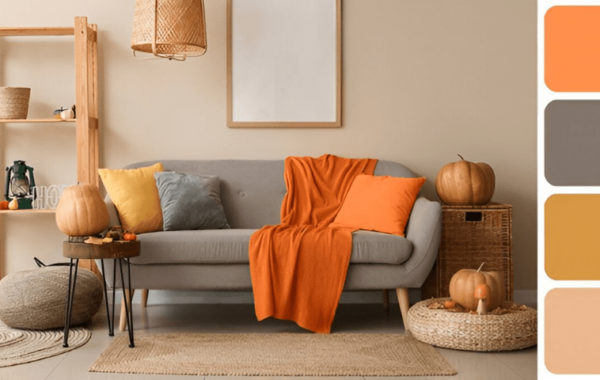
Interior Design for Wellness: Creating Health-Conscious Spaces
In our fast-paced, modern world, the importance of wellness has taken center stage. People’s awareness of how their surroundings affect their physical and emotional well-being is growing. This awareness has increased interest in creating health-conscious spaces through interior design. Interior design for wellness is a holistic approach that aims to enhance the well-being of individuals by optimizing their surroundings. This article will examine the essential ideas behind interior design for health and how you can create health-conscious spaces in simple terms
Mindful Selection of Colors and Lighting
Color and lighting are crucial in perceiving and interacting with a space. When designing for wellness, choosing colors and lighting that promote a sense of calm and tranquility is essential. Here’s a breakdown of how color and lighting impact wellbeing:
Soothing, natural colors like soft blues, greens, and earthy tones can create a calming atmosphere. These colors are often associated with nature, which positively influences health. Hence, avoiding overly vibrant and aggressive colors is essential for maintaining a serene environment.
Natural light is a vital element for wellness. It helps regulate circadian rhythms and provides a connection to the outside world. When natural light is limited, full-spectrum lighting is used to mimic the effects of sunlight. Additionally, adjustable lighting can enable occupants to control the intensity and color of light, promoting comfort and relaxation.
Biophilic Design
Biophilic design involves incorporating elements of nature into indoor spaces. As a character has a remarkable ability, it helps to reduce stress and promote wellbeing. Here’s how you can incorporate biophilic design:
Adding potted plants or small gardens can bring the outdoors inside. They improve air quality and provide a peaceful, natural ambiance.
Choose natural wood, stone, and bamboo for furniture and decor. These materials have a warm, grounding effect on spaces.
Whenever possible, ensure that the interior design allows for views of natural elements like trees, water features, or gardens. These views can provide a sense of tranquility.
Comfortable and Ergonomic Furniture
Wellness-oriented interior design emphasizes comfort and functionality in furniture selection. Comfortable and ergonomic furniture can help reduce physical stress and promote good posture. Here’s what to consider:
Choose furniture that supports the body’s natural alignment. Ergonomic chairs and desks, for instance, can reduce the risk of musculoskeletal issues and enhance productivity.
Use plush cushions, pillows, and cozy upholstery to create a comfortable and inviting atmosphere. Soft furnishings not only contribute to physical comfort but also promote relaxation.
Clutter-Free Spaces
A cluttered environment might result from a congested mind. Hence maintaining a clutter-free space is vital for promoting mental wellbeing. In simple terms, this involves:
Use storage solutions like shelves, cabinets, and baskets to organize belongings. This does not reduce visual clutter, making finding and accessing items more accessible.
Embrace a minimalist approach by reducing the number of items in a space. Fewer objects create a sense of openness and calm.
Personalization and Emotional Connection
A wellness-conscious interior should reflect the personality and preferences of its occupants. Personalization and an emotional connection to the space are essential for well-being:
Incorporate personal items like photographs, artwork, or memorabilia. These items can evoke positive emotions and make the space feel like home.
Decorate with positive affirmations or inspirational quotes. These can serve as daily reminders of goals and values.
Noise Management
One’s welfare may affect others, makes it suffer as a result of noise pollution. To create a health-conscious space, consider:
Install soundproofing materials, such as acoustic panels or curtains, to reduce unwanted noise from outside or neighboring rooms.
Use white noise machines or soothing background sounds like nature or gentle music to mask disruptive noises and create a serene atmosphere.
Proper Ventilation and Air Quality
Good air quality is vital for wellness. Therefore, in simple terms, you can achieve this by:
To ensure proper ventilation in your space. Open windows and use air purifiers to maintain fresh and clean air.
Try to use natural like essential oils or fragrant plants to create a pleasant atmosphere. Also avoid artificial air fresheners that may contain harmful chemicals.
Functional layout
The layout of a space significantly affects how it is used and perceived. A wellness-oriented interior design should have a functional and intuitive layout:
In Order create a easy flow, create a smooth flow between different areas, allowing for easy navigation. Avoid cluttered pathways and obstacles that disrupt movement.
Consider the versatility of the space. hence it will always be easily adapted for different purposes, such as relaxation or exercise.
Well-Defined Rest and Activity Areas
A well-balanced interior design should accommodate both restful as well as active activities. In simple terms, this means:
Designate spaces for relaxation, meditation, and rest. Therefore we can use comfortable seating and calming decor in these areas to keep our mind fresh and light.
Set up areas for physical activities like exercise, yoga, or hobbies. Moreover, make sure these spaces are well-equipped with the necessary tools and equipment to keep this area active always.
Safety and Wellbeing
Creating a safe environment is fundamental to wellness. In simple terms:
If children are in the household, ultimately childproofing measures should be in place to ensure their safety and secure.
Ensure the space is accessible to all, including those with mobility challenges. Therefore, Consider features like ramps and grab bars.
Interior design for wellness is about creating spaces supporting physical and mental well-being. While the principles discussed here might seem complex initially, they can be implemented straightforwardly. Whether you’re designing a home, office, or any other interior space, following these guidelines can help create a health-conscious environment that promotes a sense of tranquility, comfort, and overall well-being. The feasible way to attain interior design for wellness is to choose Cibi+Simeon Designs. Being the top interior designing company in Chennai, we take good care of the well-being of inhabitants and the environment, which indirectly impacts human wellness. Hire us for innovative and wellness interior design.


